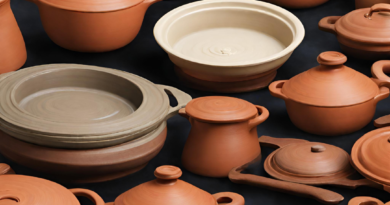What are traditional clay cooking methods?
Cooking is not just about nourishment; it’s a celebration of culture, tradition, and history. Traditional clay cooking methods, deeply rooted in various cuisines around the world, exemplify this connection. These methods have been passed down through generations, preserving the authenticity and flavors of regional dishes. In this article, we’ll take a journey through the fascinating world of traditional clay cooking methods and explore their significance in culinary heritage.
1. Tagine Cooking (North Africa)
Tagine , a distinctive North African clay pot with a conical lid, is synonymous with Moroccan and Tunisian cuisine. The tagine’s unique shape allows for moisture to circulate within the pot, creating a natural self-basting environment. This method of cooking preserves the integrity of ingredients while enhancing their flavors. Tagines are used to prepare a variety of dishes, including aromatic stews, couscous, and tender slow-cooked meats.
2. Tandoor Cooking (South Asia and Middle East)
The tandoor is a traditional clay oven that has been a staple of South Asian and Middle Eastern cuisine for centuries. This cylindrical clay oven, typically heated with charcoal or wood, reaches extremely high temperatures. It’s the cornerstone of dishes like tandoori chicken, naan bread, and kebabs. The intense, dry heat of the tandoor imparts a smoky flavor and unique texture to the food cooked inside.
3. Cazuela Cooking (Latin America and Spain)
Cazuelas , or clay pots, are an essential part of Latin American and Spanish cooking. These earthenware vessels come in various sizes and are used for preparing a wide range of dishes. From savory paellas and hearty stews to creamy flans and rice pudding, cazuelas contribute to the rich culinary tapestry of these regions. The even heat distribution of clay ensures that these dishes cook slowly and evenly, resulting in complex flavors.
4. Kamado Cooking (Japan)
In Japan, kamado refers to traditional clay ovens used for a multitude of culinary purposes. These ovens are especially well-known for their role in the preparation of kamado rice, where the clay imparts a distinctive flavor and texture to the rice. Additionally, kamado ovens are used for slow-cooking dishes like kamado-ni (stews) and kamado-meshi (clay pot rice).
5. Romertopf Baking (Germany)
The Romertopf , a German clay baker, has a long history of baking hearty, flavorful dishes. It’s particularly favored for preparing roasts, casseroles, and bread. The Romertopf’s porous clay ensures that the food remains moist and succulent during cooking, resulting in dishes that are both tender and richly flavored.
6. Chamba Cooking (South America)
In South America, especially in regions like Colombia and Peru, Chamba clay cookware is highly prized. These vessels, crafted from dark clay, are used for preparing traditional dishes such as ajiaco (a potato and chicken soup), as well as various stews and rice dishes. Chamba cookware’s ability to retain moisture and create a uniform cooking environment is key to the success of these recipes.
7. Bedourie Oven (Australia)
In the Australian outback, the Bedourie oven is a unique clay cooking vessel that’s perfect for campfire cooking. Made from local clay, these ovens are used for baking damper (a type of bush bread) and roasting meats. The clay’s insulating properties and durability make it a valuable tool for cooking in challenging environments.
Conclusion: Preserving Culinary Traditions
Traditional clay cooking methods are not just techniques; they are living links to our culinary heritage. These time-tested practices have been perfected over generations, resulting in dishes that are deeply rooted in culture and tradition. When you cook with clay, you’re not just preparing a meal; you’re preserving a piece of history and savoring the flavors of tradition. These traditional clay cooking methods continue to inspire and connect us to the rich tapestry of global cuisine.



